On Friday, September 15, we had an insightful session by Brigadier P. Ganesham, a decorated veteran of our Defence Forces.
Transformative change cannot be achieved with just top-down policies and technological solutions. Brigadier Ganesham passionately explained that we must harness the power of everyday people, their ingenuity, and their commitment to fostering sustainable lifestyles. Through captivating anecdotes and real-world examples, he illustrated how individuals and communities from diverse backgrounds have taken matters into their own hands to champion eco-friendly practices and innovative solutions.
About Brigadier (Retd) P Ganesham
Brigadier P Ganesham, a distinguished veteran born in the serene village of Bhoompally in Telangana, holds an engineering degree from Osmania University and an MBA from Delhi University. His illustrious career spans over 35 years in the Indian Army, where he specialized in Armoured Fighting Vehicles. He assumed command of a battalion stationed in Kashmir during intense counter-insurgency operations. One of his groundbreaking achievements was the development of a versatile multi-role weapon platform known as "Windy." This innovation was showcased during the Republic Day Parade in 2004. Brigadier Ganesham secured a patent for "Windy," marking the first-ever patent granted to the Indian Army.
In recognition of his exceptional service, Brigadier Ganesham was honoured with the "Vishisht Seva Medal (VSM)" by the President of India during the Republic Day celebrations in 2005.
Following his retirement, Brigadier Ganesham assumed the role of Director (Production) at Bharat Dynamics Ltd (BDL) from 2006 to 2009. He has since been an integral part of several advisory boards and committees, including Telangana State Innovation Cell (TSIC), ECHS in Telangana and Andhra Pradesh and the Rajya Sainik Board.
About Palle Srujana
Brigadier Ganesham co-founded the voluntary group "Palle Srujana" in 2005. The group is dedicated to promoting grassroots creativity and traditional knowledge in unified Andhra Pradesh. Palle Srujana disseminates grassroots innovations effectively, enabling innovators to access markets and financing for production. This model has resulted in a combined turnover of Rs 15 crores from the sale of grassroots innovations developed in the two Telugu speaking states. Over 30 production facilities are now operational in villages and towns, manufacturing 80 + "Ready for Sale" grassroots innovations.
Grassroots creativity
Grassroots creativity exists in the villages. It is significant and is important for us, for the nation and for our lifestyle.
There are two kinds of innovation which can be taken to the rural markets:
- Type 1: These are products made by the formal system for the rural community. This kind of innovation involves institutions such as the Colleges, R&D labs public and private. .
- Type 2: The products are made by grassroots people made for grassroots use. This happens in a more organic way without any organization. There is no budgeting or tasking/mandating. .
As the legendary Mr Verghese Kurien once mentioned, India’s place in the Sun will come from the partnership between the wisdom of the rural people and the skills of the professionals, to tap into the wisdom of the rural people, we must go to the villages.
Everybody, including the poor has creativity. As the Dalai Lama once mentioned, we are all striving for happiness. Happiness eludes us when we have pain. We must evolve ideas to reduce the pain of people. That is the crux of innovation. Any innovation that does not address the pain of the user is not serving its purpose.
Palle Srujana as a volunteer group nurtures grassroots productivity to provide affordable solutions to society. The group provides, voice, visibility, and velocity to grassroots innovators.
The journey
Brigadier Ganesham’s journey since he set up Palle Srujana has been fascinating. In his grounded and understated way, he explained the various lessons the group has learnt:
- Harmony between nature and people.
- Coexistence of people and nature.
- Accepting what we see.
- Unlearning and relearning what we do not know.
- Exploring forgotten temples of knowledge.
- Samvedana, i.e. feeling other’s pain the way they feel.
- Appropriate innovations that can result in simple, yet amazing creativity.
- Seeing nature as a gift of God, collaborator, and provider.
- Rediscovering volunteerism, which comes naturally to human beings.
Reemergence of individual excellence
Individual excellence has existed for centuries. It was promoted by our kings, and more recently the jagirdars and the zamindars. With the advent of colonialism, institutional excellence began to replace individual excellence.
Palle Srujana has attempted to scout the individual excellence. Scouting, documentation, and prototyping are part of these endeavours.
First, we must shed our baggage to gain the trust of the villagers. Then only they will talk to us. We must strive to get accepted by them.
Then we must enable documentation to safeguard the inventions of the villagers. In the formal system, documentation happens concurrently. But in the informal system it happens retrospectively. Volunteers have a big role to play in enabling documentation and protection of the IP. The innovators should get their due rewards. It is a huge responsibility for volunteers.
The innovation must be validated so that it gets acceptance from the formal system.
We must build on the strengths of the villagers. Strengthen their strengths. Give them what they want NOT what we can.
Accomplishments
Palle Srujana has achieved the following:
- Scouted over 500 innovations, 50 plus farm practices.
- Documented over 1000 plus traditional knowledge artifacts.
- Facilitated the grant of 32 Patents with 11 under process.
- Facilitated over 350 innovation displays.
- Enabled over 100 innovations to be taken to the market generating sales of Rs 20 crores during FY2018-22
- Over 30 production facilities in their villages for innovators to manufacture their innovations.
Examples of grassroots creativity
Cycle driven sprayer - Mansukh bhai
Sprayers consume energy and need some maintenance. The cycle driven sprayer developed by Mansukh bhai from Gujarat needs no energy. It is simple and easy to operate. It can be locally made making it affordable. It is very safe as the spray follows the operator.
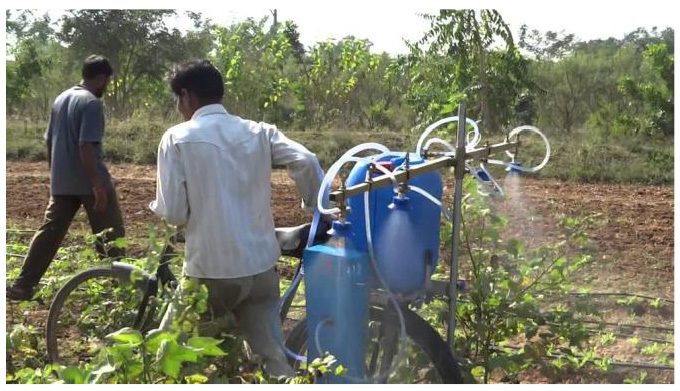
Safe and effective spraying
Spraying in paddy or wheat fields is done manually by small and marginal farmers (85%). The industry has traditionally provided a backpack with a hand sprayer spraying in front of these farmers. It is laborious and time consuming. It is also dangerous as the farm labour walks into the spray, breathing the poisonous vapours. Mallesh has made a solar sprayer with a short range. Moulali has innovated further with a 300 feet sprayer affordable by small and marginal farmers. Shashidhar ensured that the spray is behind the farmer.
Fertiliser dispenser
Last mile fertiliser dispensing has never received much attention from the captains of society. The result is a lot of wastage (up to 35%). Mahesh has developed a backpack fertilizer dispenser using simple and low technology. The farmer can select the location and quantity to be dispensed. This leads to saving in fertilizer, time and effort and higher productivity. Hemanth has increased the productivity by enabling fertiliser dispensing with both hands.
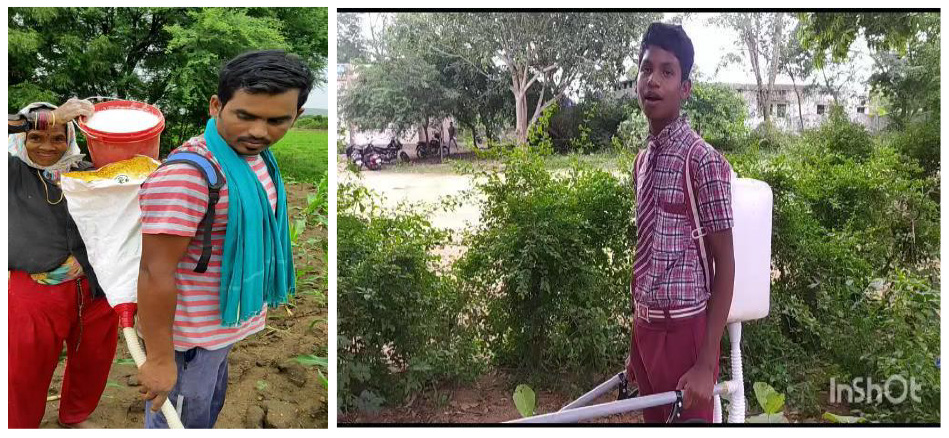
Multi-level taps
Multi-level taps enable children of different heights to consume water easily in the schools. When children see their problems are being solved, they feel grateful. It is quite likely that they will also solve the problems of others when they grow up. That is how “Samskar” (culture) develops. This innovation is another example of Samvedana.
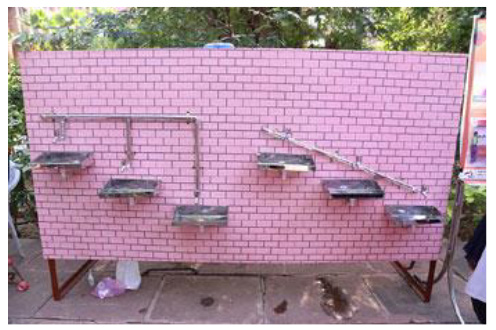
Seeding
Seeding is a very laborious activity in farming. Thousands of seeds need to be planted in the soil per acre. This is done manually by millions of men and women They must bend to do this. The process is slow and tiring.
A simple manual seeder developed by Gorre Ashok allows the farm worker to just stand erect and do the seeding effectively to the right depth, and in the right place.
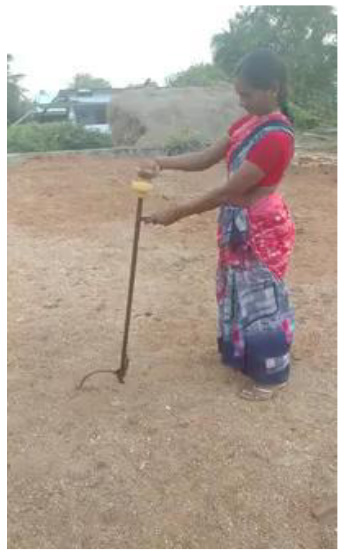
Village transporter
Kondal Nayak has developed a trolley which can be pulled easily by any two-wheeler or four-wheeler. It carries 1000 Kg load.
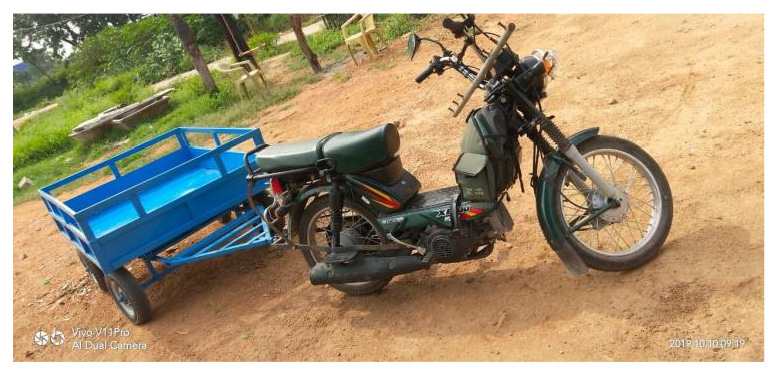
Weeding in Paddy Fields
Weeds trouble farmers immensely. They need to be removed to ensure a healthy crop. It involves labour, time, and high input cost. Chemical weedicides are hazardous.
Chandrashekhar has developed a herbal weedicide, especially suitable for paddy. It is made from the plants, uses no chemicals, and prevents germination of weeds. This is a game changer for paddy farmers with a drastic reduction in weeding costs and increased yield of up to 25%. Benefits to the environment and health are huge. Large tracts of land may not need chemical weedicide.
Easy Planter
Transplantation of dry crops and vegetables needs farm labour and consumes a lot of time and effort. Input costs of farmers go up due to manual planation of thousands of plants.
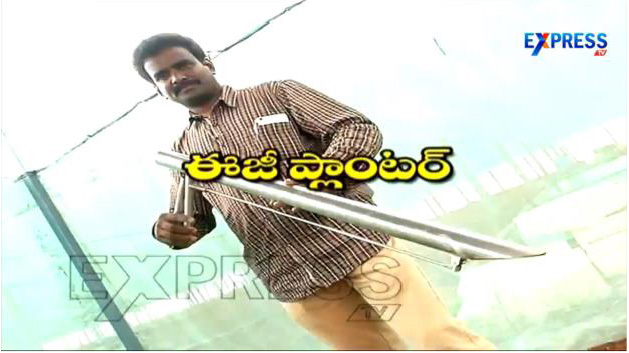
Viswanatha Raju has developed a very simple easy and quick planter. It is easy to operate, requires no maintenance, and saves time, effort, and money for the farmers.
A crane for each village
Mahipal has attached a single boom to a tractor. This boom acts as a crane and can lift 800 Kg through a height of 15 feet. A tractor can manoeuvre the crane to any place in the village. This low energy, affordable crane is a boon to the Indian villages.
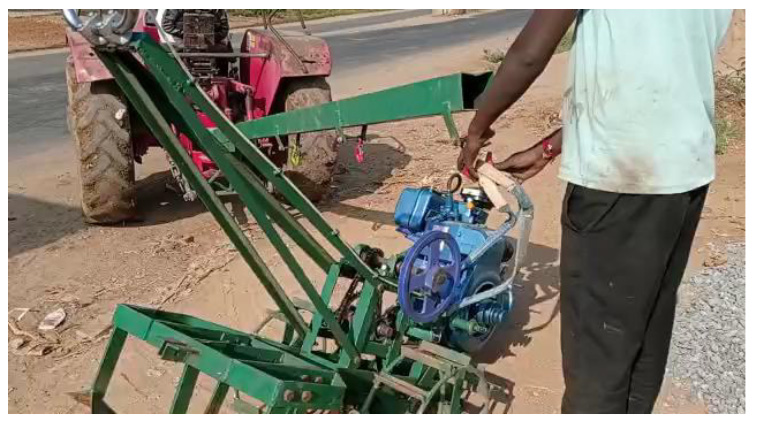
Pedal lifter for weavers
Weaving is an important occupation in the rural areas. There are 28 lakh looms in the country. About 72% of the weavers are women. The physical effort in weaving is intense. Weavers must press the pedal 5000-6000 times a day. The load on the knee can be between 25 and 35 kg. This means as the weavers age, it is difficult to continue in this occupation. Thanks to the electromagnetic pedal lifter developed by M Siva Kumar, the physical effort is virtually eliminated. Productivity has increased by 25% with enhanced quality of weaving. The earnings can continue till late in life. Even physically challenged weavers with no legs or one leg can operate the loom with a hand switch.

Brigadier Ganesham summarised the lessons learnt from these examples:
- Meeting unmet needs
- Focus on people and not technology.
- Affordable, appropriate technology that results in products which require little maintenance.
- Giving people the best products at an affordable price to enable them to give their best back to us.
- Reduction in input costs.
- Factor interconnectedness in the innovation
When we cannot solve the problem, we must at least reduce the pain through small steps. We must observe the pain, internalise it and then try to reduce it. All of us have the capacity to reduce the pain of our fellow citizens. “Knowing-Feeling and Doing” is the mantra for grassroots innovators. It is worth emulating them.
Q&A
When he was in the army, Brigadier Ganesham realized that jawans operated in difficult circumstances. They would be trained for many situations and yet face something unexpected while fighting. But the jawans would innovate and win the war. As Brigadier Ganesham in lighter vein stated : Generals plan the war. Soldiers win it.
Brigadier Ganesham realized that in any organization, people at the bottom innovate and contribute a lot. He wanted to know what happens in civil society, public and private organizations..
He met Business Tycoon, Mr Anand Mahindra who guided him to Dr R A Mashelkar and Anil Gupta of the National Innovation Foundation. ( https://nif.org.in/ NIF supports grassroots innovations developed by individuals and local communities without any help from formal sector. It also enables such innovations to diffuse widely through commercial and/or non-commercial channels, generating incentives for the innovators.)
NIF was already studying and documenting grassroots level creativity in the villages. But Andhra Pradesh was not represented. So, Brigadier Ganesham decided to settle in Hyderabad and start the work of voluntarily identifying and documenting grassroots level creativity in united Andhra Pradesh.
When Brigadier Ganesham returned to Hyderabad, he took three decisions.
- He would not earn any more. He would live on his pension.
- He would not try to use his past knowledge. He would start life fresh like a learner joining school.
- He would not work for any organization but would form a volunteer group. That is how Palle Srujana was set up.
At Palle Srujana, people decide what they want to do, when, where, how, etc. There are no targets. There is no management as there are no resources. The group evolves every day. The volunteers do great work. They know they are working for society and give their best. Palle Srujana does not handle money. It enables the innovators to make money and ensures that the money flows directly into their bank accounts.
Brigadier Ganesham emphasised that if we impose the rules of an organisation, volunteering does not work. A volunteer group is like a natural system which evolves on its own. It cannot be governed by rigid rules.
There are 3000 volunteers from all over the world. They do not need to come physically. If someone likes the concept, he is already a volunteer. There is no need to fill a form or pay a fee to become a member of Palle Srujana.
When Brigadier Ganesham returned to Hyderabad after almost 35 years, he had to start from scratch and mobilise volunteers. The idea of holding yatras was borrowed from Prof Anil Gupta. It was about creating an opportunity to interact with people and nature.
A yatra is not an organized event but a spontaneous gathering of people who go to an unfamiliar place through an unknown path with an unknown agenda. In these yatras, people sleep in temples, schools, etc. During the three days, they first unlearn. Then they keep listening to the villagers and learn the truth on their own. They see villagers living in harmony with nature. They understand the strengths of the villagers and the problems they face. Each individual picks up his or her insights. These insights incorporate the fundamental truths of nature and greatly enhance the quality of their decision making.
Unlike the formal system, visiting cards do not work here. The villagers assess and gauge us by the interactions with them and our behaviour. We must convince them about the genuineness of our intent. For this, we must shed our baggage (army, corporate, etc) and become a common man. For Brigadier Ganesham, it took 2-3 years. Once they accept us and start trusting us, the villagers begin to share everything with us. Genuine conversations will follow. Then we will become responsible for carefully nurturing their creativity. We have to live up to their expectations. On their part, the villagers will pardon us if we make a mistake unintentionally. .
Unlike the formal system, visiting cards do not work here. The villagers assess and gauge us by the interactions with them and our behaviour. We must convince them about the genuineness of our intent. For this, we must shed our baggage (army, corporate, etc) and become a common man. For Brigadier Ganesham, it took 2-3 years. Once they accept us and start trusting us, the villagers begin to share everything with us. Genuine conversations will follow. Then we will become responsible for carefully nurturing their creativity. We have to live up to their expectations. On their part, the villagers will pardon us if we make a mistake unintentionally. .
The focus of Palle Srujana is on capturing and disseminating of knowledge. Not on using advanced technology. In all grassroots innovations, technology is there in some form, but it is appropriate and affordable.
One creative villager may see a problem and find a way to solve it. But he would find it difficult to disseminate that knowledge. This is where Palle Srujana comes in. It takes the idea to other villages which can benefit. It is easy to absorb, customize and maintain this kind of technology because it is coming from the same environment and not being imposed from outside. This implies horizontal dissemination.
The grassroots innovations in the rural areas are driven by a different purpose and a different set of values. Interconnectedness is an important consideration. Holistic approaches are key. Farmers live in nature and deal with soil, water, heat, insects, life, etc. Only people who know the problem well, feel the problem and then do something about it will be able to come up with a satisfactory solution.
With 124 agri zones in the country, standardized technology cannot be an optimal solution for such a vast diversity. What we need are local solutions. Today, we are embracing western technologies. In some cases like harvester, the outcomes have been disastrous, such as the burning of fields by farmers
Palle Srujana believes villages are made by God. They are rooted in Indian culture. There is a strong emphasis on regeneration and sustaining the environment. The formal system prioritizes growth which is based on production and consumption. The rural eco system is based on regeneration. A good example is the tamarind tree. Grassroots innovations emerge purely out of volunteerism, Samvedana and Values of the people. They factor in diversity and interconnectedness by default in their innovations.
Currently, the formal and informal innovation ecosystems function in silos. They need to come together and evolve synergy and reduce the gap. For that to happen, people in the cities must spend more time in the villages to understand the problems and come up with the best solutions, ie Samvedana based solutions. .
Brigadier Ganesham gave a good example to show how the villages are ahead in sustainability. In the villages, people generate firewood using branches that have fallen on the ground, not by cutting trees. It is also proved that carbon emissions are less with firewood than LPG. It is also observed that utilization of heat generated from wood is higher than gas stoves.
Palle Srujana works closely with students. It is easier to influence these young minds about grassroots innovations. Unnat Bharat Abhiyan (UBA), which envisages transformational change in rural development by engaging the college students through mutual respect and mutual learning) has tasked the Colleges to support five villages by each institute. Students should identify problems and develop solutions. They should scout and identify at least one grassroots innovation every month. The students should be guided on how to do the documentation. So, many ideas get collected and their dissemination after suitable reengineering would benefit the society immensely..
Palle Surjana also organizes Gyan Shodhs. Group of volunteers including college students spend three days in the village understanding the lifestyle of the villagers and their innovations. They assess the village after getting accepted by the village. It is pure voluntary activity for the benefit of villagers. Brigadier Ganesham is confident that this way, we will be grooming the responsible citizens of tomorrow.
Palle Srujana does not believe in measuring impact. During its regular webinars, the innovators present their solutions. Farmers and scientists discuss how the idea can be used. It is up to them to judge whether there will be an impact. Society must find ways of utilizing the idea and create an impact.
But Palle Srujana is fully convinced that all grassroots innovations address some unmet needs. They reduce pain in some form. They are not meant to meet fancy desires but solve pressing problems – the UNMST NEEDS.. Palle Srujana is confident that they will have an impact. It may be necessary to measure impact to guide future investment decisions.
When it comes to learning, we should have a spirit of humility and openness. Brigadier Ganesham narrated an interesting story. He was in Araku Valley (near Visakhapatnam) with a French journalist. They saw a farmer coming towards them with a huge flock of sheep. The journalist wondered how the shepherd could identify each sheep individually. Brigadier Ganesham responded that the farmer would have his own ways of doing this. The journalist was not convinced. So, they asked the farmer the question. The farmer gave an understanding smile and opened the French book the journalist was holding. He pointed at the letters and said all letters look same to him. just like all the sheep looked the same to the journalist. No one is superior. If one is in learning mode, people share their wisdom. The lesson is that we should not be dismissive about anyone. We can all learn from each other. Shall we start respecting every other person?
Students should focus on building capabilities and developing new technologies rather than becoming worried about placements. Research reveals that we are never satisfied in life. Once we reach our material targets, we set a higher target. We focus on how to live. But if we are clear about why we are living and fix our material goals, everything will be sorted out. The world revolves around interdependence and coexistence. We should be contributing towards this. We should explore the unknown and not stay within our familiar territory. That is how we can develop competencies and capabilities.
